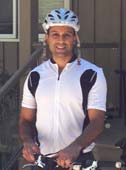Osteoarthritis and the Metabolic Syndrome

Rajiv Gandhi
|
Rajiv Gandhi is an orthopaedic
surgeon at Toronto
Western Hospital studying
the often misunderstood
link between weight loss
and arthritis. "Obesity has
an important causal role in
osteoarthritis, but it is not
simply the wear and tear on
joints related to the weight
of the obese subject. It’s the
inflammatory and biochemical
effects of obesity. Patients who lose weight from 260
to 250 pounds report a remarkable improvement in their
osteoarthritis that cannot be related exclusively to the
reduction in weight borne by the joint. It has also been
our observation that shoulder arthritis is improved by
weight reduction in obese patients, though the shoulder
joint bears no weight. The pathways linking obesity to
osteoarthritis lead to overlap with other problems associated
with the metabolic syndrome, such as hypertension,
hypercholesterolemia, diabetes and heart disease. As
understanding of the pathway evolves, patient education
should allow us to modify risk factors for prevention and
treatment."
"Recently identified hormones from fat cells and receptors
for these hormones are found inside the hip and
shoulder joints that are proving important clues in the
understanding of osteoarthritis."
The investigative team is focusing on hormones, pain
pathways in the joint and cell death. The team is comprised
of PhD scientists, laboratory technicians and
numerous assistants. Raj works with Nizar Mohammed,
who does translational and study design work with him.
"The metabolic picture is becoming clearer. Osteoarthritis
is not a disease of cartilage alone. It affects periarticular
tissues, the capsule, tendons and muscles surrounding
the joint. The entire structure is diseased. The hormones
affect the microvasculature, resulting in instability of
the subchondral bone support structure as well as the
cartilage. Everything is damaged. Naively, we postulated
weight on the joint as the sole factor, but since
the shoulder, a large, but non - weight bearing joint is
affected by hormones derived from fat, there is clearly
another explanation. Fat is not a generic component.
There are many fat compartments, which vary in their
influence. Intra-abdominal fat and abdominal wall fat as
well as pericardial fat are more metabolically active than
subcutaneous fat. Advanced glycosylation products like
glycosolated hemoglobin are likely some of the damaging
metabolites. They damage diabetic skin, and cause
cataracts as well as affecting the cartilage and subchondral
bone."
"Osteoarthritis is not one disease with one mechanism.
There are 2 broad categories. Some patients have solitary
manifestation in one joint, whereas others have generalized
osteoarthritis involving their knees, back, hips and
fingers. The pathways are related, but different. Most
of our studies focus on the generalized osteoarthritis
phenotype. The answer, as often, will come from careful
phenotyping and pathway analysis. We are also exploring
|
stem cell therapy, as stem cells have strong antiinflammatory effects. We are using bone marrow derived stem cells and embryonic stem cells with April Craft in the McEwen Centre. Pluripotent cells are derived from umbilical cords and bone marrow. Bone marrow cells can be backed into a multipotent form. They can be redirected toward differentiating into heart, bone and nerve cells. Stem cells may also regenerate cartilage. The cartilage is avascular, but the subchondral bone is the key factor. Microvascular disease affects the subchondral bone, limiting the nutrition of cartilage."
The goal of the lab is to characterize the pathway
between the fat cells and the joint, and ultimately to
identify the entire pathway sketched in Figure 1.
 Figure 1
|
Raj works with the bariatric surgery group at Toronto
Western. They harvest visceral fat from the abdomen,
which is studied in the lab and compared with fat from
an independent sample of joint surgery patients.
RESEARCH ETHICS BOARD
Raj became interested in serving on the Research Ethics
Board as he struggled to get protocols approved to
answer the question: Why does losing only 10 pounds
from 260 to 250 pounds make knee pain so much better?
Taufik Valiante from Toronto Western, a neurosurgeon
interested in epilepsy is the other surgical member
of this board. "The Research Ethics Board is interesting.
I learned methodology and I learned about industry
links and the troubles associated with it. Bioethicist Kyle
Anstey is a great resource."
Raj is the first medical professional in his family. He is
an active golfer, and mountain biker. He enjoyed his
sojourn at the Harvard School of Public Health. He and
Raj Rampersaud have recently completed a qualitative
study of the factors that influenced patient choice to
undergo surgery.
M.M.
|